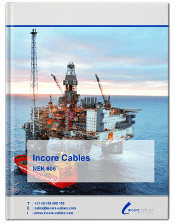Arctic offshore cables
Offshore installations endure a number of difficulties in de great and deep oceans. Cold temperatures are one of them. NEK 606 has specified that offshore cables need to stay operational with temperatures form -40°C up to 90 °C. They need to endure a minimum temperature of -40 °C where the cable must remain flexible and operational.

With the undiminished need for oil and gas, undiscovered frontiers are being researched and will be exploited in the future further away from the main land. The Arctic is one of the frontiers which has a lot to offer in terms of gas and oil. In fact, the US Geological Survey estimates that the Arctic holds around 30% of the world’s undiscovered natural gas, as well as 13% of its oil and 22% of its natural gas liquids. The Arctic has more extreme weather conditions. The question rises: do we need special arctic offshore cables?
Challenges for Arctic offshore cables
The Arctic offers more challenges to arctic offshore cables than common offshore operation conditions. These challenges entail the great distance from the mainland, limited infrastructure and communications, environmental concerns and extreme temperatures. Arctic temperatures can range between -50 °C and -60 °C, making the current specification for offshore cable insufficient. Furthermore, materials can be quickly damaged by ice and corrosion.
- Ice formed from seawater always contains a small amount of water that has not solidified. Salt concentrations in this water are always high. This can result in faster corrosion than seawater alone would have caused.
- The ice tears off paint layers more quickly which increases the damage as paint was applied to protect surfaces from corrosion.
- The hardness of ice crystals varies with hardness increasing as temperatures drop. This increases wear and tear.

Forming of ice crystals on arctic offshore cables would have a negative effect as well. The sheaths of the cables need to withstand this kind of wear to protect the inside of the cable to prevent the cables from losing their functionality. These challenges need to be addressed and a new standard/specification needs to be developed for the offshore industry.
International Committee
In 2011, ISO technical committee ISO/TC 67 “Materials, equipment and offshore structures for petroleum, petrochemical and natural gas industries, subcommittee SC 8, Arctic operations” was created in Moscow. The committee includes representatives from the Netherlands, Norway, Russia, Canada, Italy, France and Germany.
The committee has already explained that they are working on the following topics:
- Material requirements for load-bearing structures.
- Production requirements.
- Operation and maintenance task requirements.
- Corrosion control.
- Repairs.
- Integrity and lifetime calculations.
The committee intends to make this inevitable process as painless as possible for the environment, as lucrative as possible for industry and as safe as possible for those people working in the planet’s most extreme environment to meet the world’s ever increasing demand for petroleum products.
More about the NEK 606?

Receive our eBook and you will find more information about:
- About NEK.
- Standards.
- Organizational structure.
- Oganizational policy.
- History of NEK 606.







